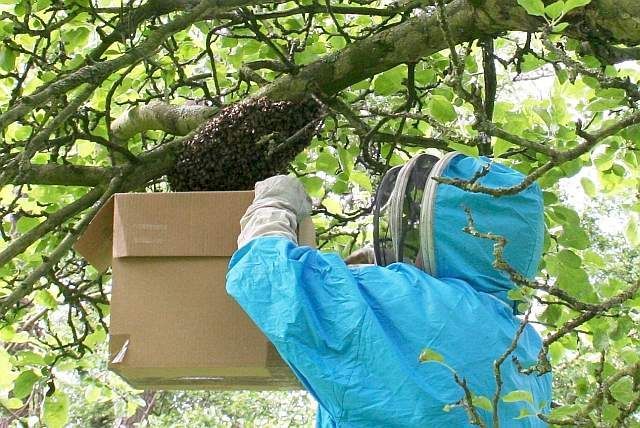Swarming
Are you a beekeeper or a bee-loser?
Many beekeepers accept swarming as an inevitable event. Sadly, it results in a significant loss of bees and impacts honey yield and may result in complete colony loss. Furthermore, the need to remove swarms from buildings may cause distress, inconvenience, structural work and cost to neighbours. On our beginner and improver courses we stress the importance of swarm control and share effective management practices with our students that virtually eliminate the occurrence of swarming.
First of all, lets investigate what happens when bees swarm and what triggers this to happen. Swarming is a natural process that honeybees undertake in an attempt to reproduce and spread by dividing and starting new independent colonies. In preparation for swarming, the colony initiates the rearing of new queens. Then the old queen and a significant proportion of the flying bees from the colony leave the hive in an attempt to set up home elsewhere. New queens are reared in specially constructed structures called queen cells. An egg, laid in these structures by the old queen hatch into larvae, that are then fed with copious quantities of a high protein diet of royal jelly, derived from pollen and provided by young nurse bees. Around the eighth day after the egg was laid, feeding stops and the queen cell is sealed with a cap of wax and the larvae pupate. It is on this day that the old queen and accompanying flying bees swarm from the hive, leaving behind some workers and some developing queens in their queen cells to hatch out in a further eight days.

Sealed queen cells
In the days leading up to swarming, some of the workers, called scout bees, start a search of the neighbourhood for possible sites to set up a new home. Then when the big event happens, the swarm dramatically swirls out of the hive, darkening the sky, frightening bystanders with their roar. They often temporarily settle nearby on a tree, bench, fencepost etc. whilst the scout bees do a final reconnaissance. After a pause of possibly a few hours, they take off again to head to what might be a permanent home, strangely, this seems to happen consistently before 4pm.
Naturally, swarming bees seek out cavities in trees. However, with authorities cutting down old and decaying trees for safety reasons, suitable cavities in old trees are becoming fewer and far between. As a consequence, honeybees seek out alternative man-made cavities, including chimneys, flues, cavities in walls and attics, post boxes, compost and refuse bins. Sadly, the survival rate of swarms may be as low as 20% and the survival of the remainder of the original colony is not guaranteed as it depends on the successful mating of a new queen, which is weather dependent and risky as queens returning to their hive from a mating flight have to run the gauntlet of swallows and other predatory birds.

A swarm hanging from a tree
Although swarming is a natural process and some strains of honeybees are more inclined to swarm than others, generally, the swarming process is triggered by congestion or overcrowding in the hive. A vigilant beekeeper can detect the early signs of swarm preparation and halt the process by conducting regular hive inspection at intervals of 7 days or less, i.e. a day less than the 8 days it takes for a new queen cell to develop and be sealed.
My swarm prevention starts with religiously removing and relocating frames full of honey from the brood box to release more space for the queen to lay. When the queen is at her peak egg laying rate, this may not be enough and I resort to a management practice publicised by an American beekeeper called George Demaree in 1892. In essence, the brood box is decongested by replacing the upper of the two brood boxes with a new box of empty frames of honeycomb. After ensuring that the queen remains in the lower brood box, the removed brood box is relocated at the top of the hive, below the roof. The nurse bees from the lower brood box will be able to work their way up to it to feed the young brood developing there and this further diverts the bees and decongests the lower brood box and effectively delaying the onset of swarming by a few weeks till the brood hatching out join the lower brood box.
On the discovery of developing swarm cells an approach akin to fire fighting is required where the spread of fire depends on the presence of three factors: fuel; oxygen and suitable temperature. If one of these factors is removed, a fire cannot develop. Similarly, with swarming, the three crucial factors are: a queen; flying bees and queen cells. Remove one and the bees are unlikely to swarm. For example flying bees will not swarm without a queen and a queen obviously cannot swarm by herself without the flying bees. Many of the recognised methods such as those named after Snelgrove and Pagden may successfully prevent swarming by removing one or other of the three factors. However, they inevitably result in splitting the colony in two and establishing a second colony. This weakens the original colony, impacting the honey crop and the colonies’ survival depend on the survival of the original queen in one part of the split and a new queen being successfully reared and mated in the other half. One or both frequently fail!
Contrary to common use today, Demaree’s manipulation as described above was originally designed to deal with colonies that have already started down the road of swarm preparation. It has become my preferred method of reactive swarm control as it effectively separates the queen and flying bees from the developing brood and nurse bees without the use of any specialist equipment. Furthermore, the queen remains safe in the bottom of the hive and continues to lay there without interruption and the colony, not being weakened by being split into two, remains a strong powerhouse for honey production.

So, what happens to the colonies that swarm? Some beekeepers rely on collecting swarms as a means of making an increase in numbers and replacing winter losses and during the next two to three months I often get several calls or messages per day from distressed members of the public. Collecting swarms can be a fascinating and rewarding activity. After all you could end up with some freebies (free bees…. Sorry!) However, the bees are often of an unknown quality and often exhibit undesirable traits such as aggression and a higher tendency to swarm. Furthermore they may spread devastating contagious bee diseases such as European foul brood. For this reason I resist the temptation to collect swarms and rely on intentionally rearing my own bees and selectively breeding for traits such as calm behaviour, disease resistance and fecundity.
That said, swarm collecting is a fascinating process, particularly if they rest in an easily accessible location such as the lower branches of a tree. I start by spreading a bed sheet on the ground beneath the tree and then, with the aid of secateurs, prune the branch on which the swarm is hanging, until the it drops into a cardboard box held beneath it. The box is then covered with a loose lid and turned upside down on the bed sheet with one edge propped up with a wooden block to form an entrance. Next the “bee whispering” begins and over the next 30 minutes or so, all the remaining airborne bees are lured down to the bed sheet and steadily march into the box, as if by magic! If truth be known, it’s the bees already in the box that cast a spell on the others by releasing a chemical signal or pheromone to draw them in. This pheromone, commonly called the ”come hither pheromone” is released from their Nazonov gland, located just beneath the tip of their abdomen. Bees typically adopt a “bums in the air” pose and fan their wings to disperse this pheromone. It’s then a simple matter of tying up the corners of the bedsheet and transporting the swarm to be rehomed in an empty hive.

Collecting a swarm
Our “be a better beekeeper” one-day beekeeping refresher or improver's course at Anglesey Bees are available on demand and aim to reduce the loss of bees through swarming and improve winter survival through adequate autumn feeding and effective varroa control.
Comment on my blog












